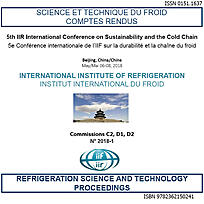
Document IIF
Projet Freezewave H2020 : congélation de pomme de terre assistée par micro-ondes.
Freezewave H2020 project-microwave assisted freezing of potato.
Numéro : pap. 26
Auteurs : JHA P. K., JURY V., CHEVALLIER S., et al.
Résumé
In the recent times, several novel freezing techniques have been attracting remarkable attention not only within the scientific community but also in the food industry due to their ability to enhance the formation of small size ice crystals and to prevent food products from freeze-damage. One of these is freezing assisted by electromagnetic waves. This short study was intended to investigate the impact freezing under low power microwaves (MWs) (2450 MHz) had on the freezing time and the microstructure of the potatoes. The time taken by the conventional freezing process to reach – 10 ? from 6 ? was 13.95 min, while the same
temperature change was achieved within 37.53, 19.87 and 20.18 min for short pulse high power (SPHP), long pulse low power (LPLP) and constant microwave (MW) freezing conditions, respectively. Although that the application of MWs during freezing process, as it was expected, resulted in longer freezing time compared to conventional freezing condition, the image analysis (X-ray micro-computed tomography) results revealed that the application of MWs during freezing process produced better microstructure than the
conventional method.
Documents disponibles
Format PDF
Pages : 6
Disponible
Prix public
20 €
Prix membre*
Gratuit
* meilleur tarif applicable selon le type d'adhésion (voir le détail des avantages des adhésions individuelles et collectives)
Détails
- Titre original : Freezewave H2020 project-microwave assisted freezing of potato.
- Identifiant de la fiche : 30023371
- Langues : Anglais
- Source : 5th IIR International Conference on Sustainability and the Cold Chain. Proceedings: Beijing, Chine, 6-8 avril 2018
- Date d'édition : 06/04/2018
- DOI : http://dx.doi.org/10.18462/iir.iccc.2018.0026
Liens
Voir d'autres communications du même compte rendu (72)
Voir le compte rendu de la conférence
Indexation
-
Thèmes :
Congélation des aliments;
Légumes - Mots-clés : Structure; Pomme de terre; Micro-onde; Experimentation; Cristallisation; Congélation
-
Evaluation of microwave assisted freezing (MAF)...
- Auteurs : XANTHAKIS E., HUEN J., ELIASSON L., et al.
- Date : 06/04/2018
- Langues : Anglais
- Source : 5th IIR International Conference on Sustainability and the Cold Chain. Proceedings: Beijing, Chine, 6-8 avril 2018
- Formats : PDF
Voir la fiche
-
Freeze stability of starch mixtures. Interest o...
- Auteurs : LE BAIL P.
- Date : 07/04/2016
- Langues : Anglais
- Source : 4th IIR International Conference on Sustainability and the Cold Chain. Proceedings: Auckland, New Zealand, April 7-9, 2016.
- Formats : PDF
Voir la fiche
-
Freezewave: a new european project on freezing ...
- Auteurs : LE BAIL A., CURET S., HAVET M., et al.
- Date : 06/04/2018
- Langues : Anglais
- Source : 5th IIR International Conference on Sustainability and the Cold Chain. Proceedings: Beijing, Chine, 6-8 avril 2018
- Formats : PDF
Voir la fiche
-
Effect of supercooling freezing on the blanched...
- Auteurs : POUDYAL R. L., WATANABE M., SUZUKI T., NIMU B.
- Date : 26/08/2020
- Langues : Anglais
- Source : 6th IIR International Conference on Sustainability and the Cold Chain. Proceedings: Nantes, France, August 26-28 2020
- Formats : PDF
Voir la fiche
-
Investigating the microstructure of frozen food...
- Auteurs : NDOYE F. T., BOUABDALLAH A., BENKHELIFA H.
- Date : 11/04/2022
- Langues : Anglais
- Source : 7th IIR International Conference on Sustainability and the Cold Chain (Online). Proceedings: April 11-13 2022
- Formats : PDF
Voir la fiche
